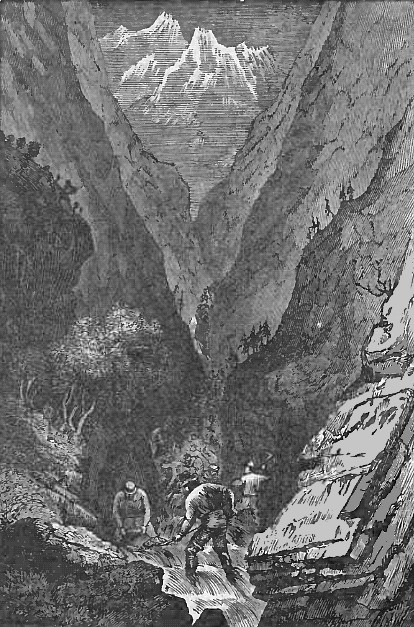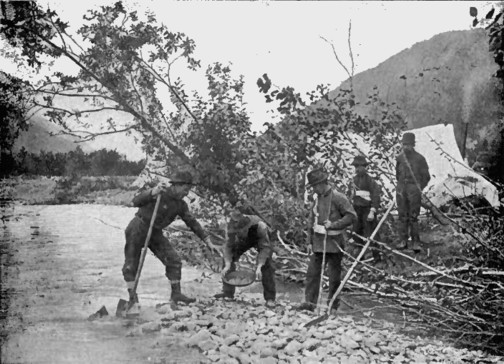Had man come upon the scene immediately following the disturbance which created the ore deposits of Cripple Creek, he would have found this network of rich veins cutting in all directions over an area of ground about 346 miles in extent and would have found no difficulty in putting up countless numbers of stakes on veins easily distinguished at the surface. He would have found Cripple Creek an uninviting place in which to live at that time. Where now are rolling, grassy hills topped with pines, and valleys coursed by timid streams, would have been only bare, rough, harsh heaps of lava. Nature has been busy in the ages that have elapsed in spreading a mantle of beauty over the barren mounds and ugly gashes that resulted from the eruption. "The effects of air and water have rounded off the protruding rocks, scored off and softened them, Covering the country several feet deep with loose earth and finely-ground rocks, which nourish the vegetable growth, but at the same time cover over and hide from the prospector the vein he seeks. "To find the vein he must dig down through the eroded covering of the rocks. In this covering called 'wash' he finds bits of the quartz filling which has suffered the same process as the country rock, and that encourages him to dig the harder. He knows this detached quartz did not come from below and that he must dig up-hill to find the vein it came from. He follows up these bits of 'float' in the 'wash' until often he must dig a trench from two to twelve feet deep to get below the effect of the erosion and into solid formation, and any length until he finds his vein in the unaffected country rock.
"The effect of the elements on the vein he generally finds has extended even deeper. Water makes of the softer vein a channel, and percolating through the quartz filling generally carries out or 'leaches' the quartz for a considerable distance down into the earth. So that after finding his vein the prospector has only begun his work. "He must next have an ore chute or find that part in his vein where the gold is in the quartz. There may be a vein without an ore chute or the chute may fill the entire crevice from wall to wall and from end to end, as a sandbar in a river from bank to bank and for miles along its course.
"A peculiarity in the structure of ore chutes in the Cripple Creek district has been noted in some of the veins. "In most camps these chutes run from the surface down perpendicularly toward the center of the earth, but here they appear to lie horizontally, so that the shaft sinking down encounters one after the other, and finds them increasing in size and richness. "The geological difference between Cripple Creek and Leadville, where a similar intrusion of porphyry occurs, is this: In Leadville the intruding porphyry from below found a hard capping of rock to resist it, and instead of breaking to the surface it elevated the cap and flowed under it, spreading out as a blanket below. "Here in Cripple Creek the eruption was greater and more forcible, spread over a wider area of country, and broke and seamed into more veins." In a monograph prepared after a geographical survey of the country for the United States government, Mr. R. A. F. Penrose, Jr., of the University of Chicago, has written the following: "The ores of the Cripple Creek district are almost exclusively gold ores. A little silver occurs in most of them, but usually it is insignificant. No other metals occur in quantities of commercial value. The ore consists usually of country rock more or less impregnated and replaced by quartz and other minerals, among which the most abundant are fluorite, opaline silica, kaolin, iron pyrite, and other iron minerals, manganese oxides, and more rarely small quantities of galena, cerrusite, malachite, argentite, tetrahedrite, stibnite, sphalerite, calaverite, native gold, oxidized tellurium minerals, gypsum, calcite, and numerous other minerals in still smaller quantities. The ores often consist simply of country rock, either eruptive materials or granite, containing secondary quartz and associated minerals, instead of, as in many gold districts, and, in fact, as in parts of the Cripple Creek district, consisting of well defined bodies of these materials. A characteristic ore of the district is an intimately mixed mass of quartz and fluorite, prominent on account of its brilliant purple color. "The gold occurs in the ore as free native gold, and telluride of gold. The usually superficial mode of occurrence and the physical condition of the native gold indicate that it has been largely derived from the telluride by oxidation. Most of the gold at a depth is in the form of a telluride which has been determined to be calaverite.
"Superficial alteration has caused the oxidation, hydration and leaching of certain minerals in the ore deposits, as well as the formation of sulphates, phosphates, hydrous silicates, tellurites or tellurates, and other oxidized compounds. The value of the ores at present shipped from the mines varies from $20 to $400 per ton. The district is at present essentially a shipper of only high-grade ores. "The gold of the Cripple Creek district occurs both in vein deposits and in placer deposits derived from the decay and erosion of the veins and country rock. The placers are not considered in the output. "The existence of numerous dikes in the region indicates the presence of preexisting fissures. In some places the veins occupy these early fissures, but in a general way the vein fissures do not seem to have been the earliest ones formed, though many of them were produced before the dike action ceased. In most cases which have been examined, however, the fissures occupied by the veins were formed after the intrusion of the dikes, as is shown by the fact that they intersect the latter. "The fissuring action affected both the volcanic area and the surrounding granite, so that 'the whole region is much broken by numerous fissures intersecting each other at various angles. In any single locality one general course is usually prominent, though intersecting fissures of less prominence are always present, and in some places there are two or more systems of parallel fissuring. The general course of the fissures carrying the veins of the district, like that of the dikes, varies from northeast to northwest; often it is nearly due north and south. Some of the fissures occasionally strike more nearly east and west, but in most of the important veins the more northerly trend is distinctly characteristic. "The fissures are usually represented by one main fracture with numerous subordinate parallel or approximately parallel fractures, though sometimes two or more main fractures occur close together, and frequently there is no one specially well-defined break, but a number of closely parallel fissures of about equal magnitude, giving the rock a minutely banded or sheeted structure and forming a fissured zone.
"The fissures are usually the result of movement probably accompanied by a certain amount of faulting, as is proved by the occasional occurrence of fragments of rock in the better defined fissures and the abundance of grooves or slickensides on their faces. The evidence so far obtained indicates that the faults in the vein fissures have throws varying from a fraction of an inch to several feet. Outside of the immediate Cripple Creek district, however, faults of much greater magnitude occur, sometimes with a displacement of over 1,000 feet. "What has been said of the general mode of occurrence of the fissure holds true of the veins, which are simply bodies of secondary minerals filling the fissures. Sometimes the veins are single, well-defined bodies of ore and sometimes they are thin parallel seams filling the fissured zones. They occur in all the rocks of the district breccia, massive eruptives and granite. The general character and mode of occurrence of the ore make it evident that the veins are, largely at least, a replacement of the country rock along very narrow fissures, which were hardly more than cracks, though occasionally the ore appears locally to have filled small open places along them. Every gradation can be seen, from country rock slightly impregnated with ore along a fissure to country rock completely replaced and converted to a well-defined vein.
"It is notable that the veins often follow dikes, either throughout their course or, more commonly, for short distances, and that when a vein meets a dike, though it may cross it directly, it is likely to be deflected and to follow the dike for a greater or less distance. It is often noticeable that near the surface both veins and dikes dip at angles different from those seen at a depth; while sometimes veins that occur in one well-defined fissure at a depth fork near the surface. The fissures occupied by the dikes or veins were confined to the original line of breakage at a depth, on account of the superincumbent pressure, while nearer the surface this pressure was relieved, numerous traverse breaks of a more or less superficial character were encountered, and the fissures were more easily deflected or divided. "Sometimes cracks or sheeted zones occur in dikes at their contacts with the country rock, and follow all the curves in the meanderings of the dikes in a way that would not be likely to characterize independent and subsequent fissures. The sheeted structure here is probably caused by shrinkage of the dikes along the contact with the country rock during cooling. The shrinkage cracks are probably not so deep-seated nor so far-reaching as the fissures caused by the later dynamic disturbances, and, therefore, when unaffected by such fissures, they probably have rarely, if ever, become the repository of important ore bodies.
"The concentration of gold in fissures requires not only a source of gold but also the re-agents (generally hot solvent solutions under pressure) necessary to dissolve the disseminated metal, to carry it into the fissures, and there, by one or more of the many methods, to deposit it. It is a noticeable fact throughout the Cripple Creek district that the richest veins occur in eruptive rocks or in granite in the vicinity of the vent or vents from which the eruptives were ejected. In such positions, as the result of subsiding eruptive activity, the rocks were subject to the action of hot waters impregnated with various solutions; and these waters seem to have been the re-agents that dissolved the gold and caused its concentration in fissures. Hence the veins are rich in and near the areas of the vents and become poorer as distance increases; and hence also the eruptive rocks probably supplied most of the gold, while the immediately adjacent granite may have supplied a certain part."
Return
to The Colorado History Page:
Colorado Gold Rush History


